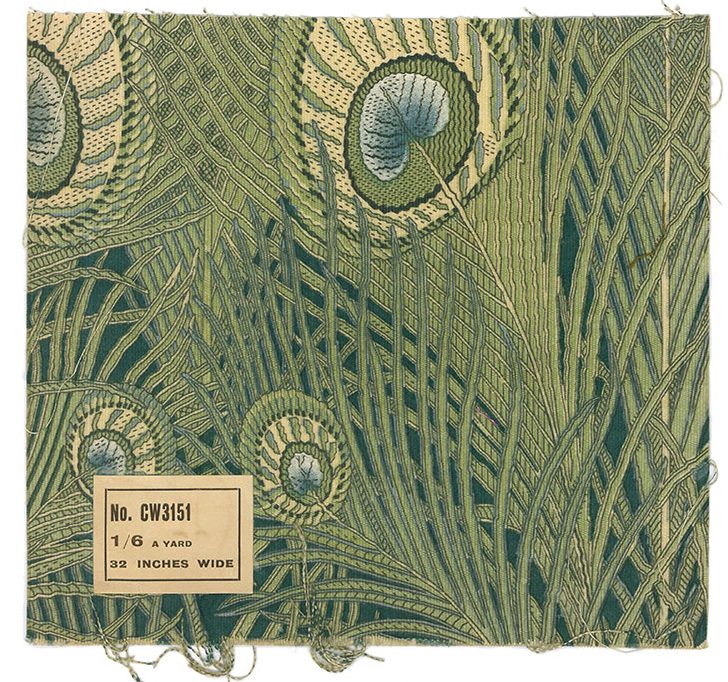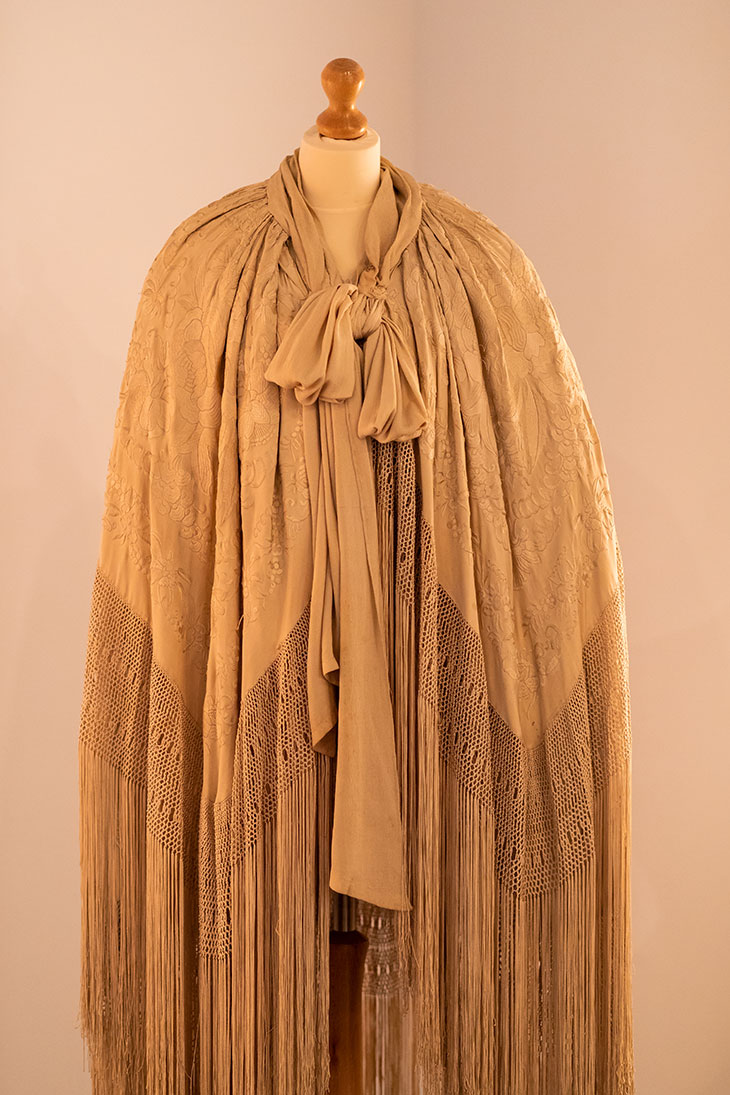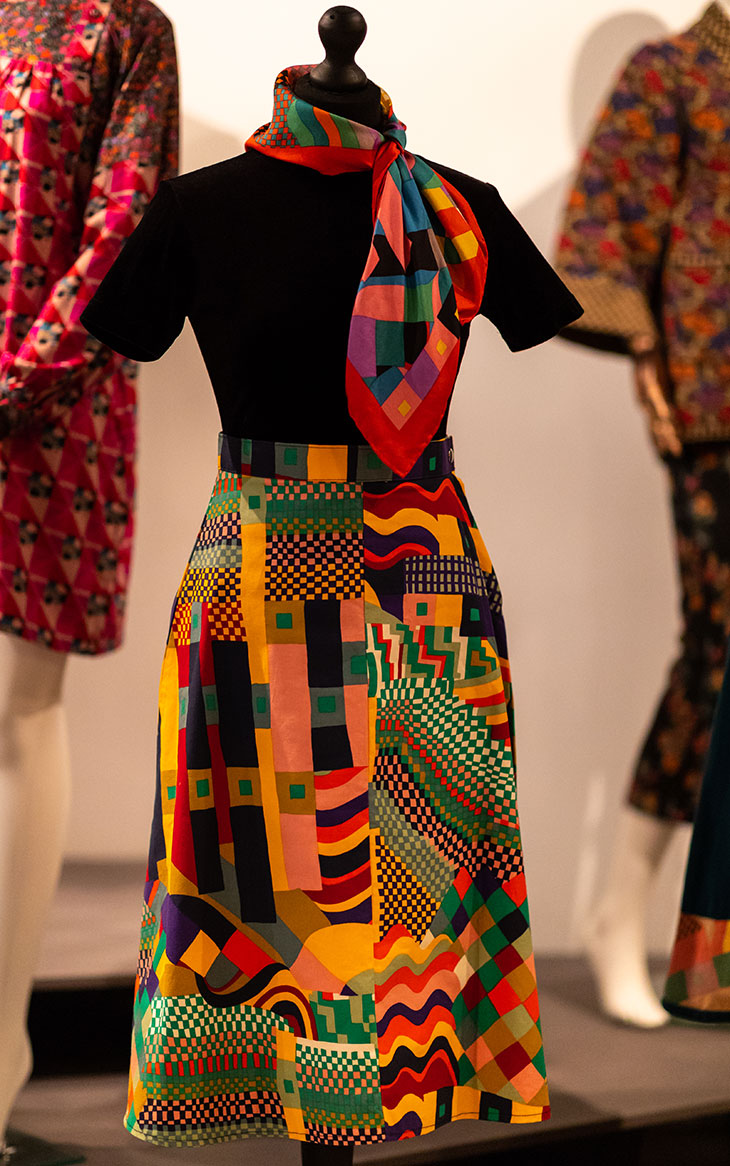It is rather extraordinary for a department store to promote an educational agenda, but in the mid 1880s that is precisely what Arthur Lansenby Liberty did with the establishment of the Costumes (also known as ‘Art Dress’) Department in his Liberty shop. According to the store’s earliest catalogues, dating from 1886, the department was ‘arranged for the study and execution of Costumes, embracing all periods of Historic Dress, together with such modification of really beautiful examples as may be adapted to the conventionalities of modern life, without rendering them eccentric or bizarre’. The legacy of the Costumes Department is clear to see throughout the ‘Liberty Art Fabrics & Fashion’ exhibition at Edinburgh’s Dovecot Studios, where more than a century’s worth of billowing sleeves and flowing skirts – not bizarre, but perhaps eccentric – are now on display.
While his motives were not altogether altruistic – it was undoubtedly an excellent marketing strategy for appealing to the cultured consumer – A.L. Liberty’s desire to educate was not disingenuous, judging by his active involvement in dress reform societies of the day, particularly those which promoted Artistic Dress. Worn mostly by those in artistic circles (artists, architects, designers, models, and patrons), the sartorial style communicated an identification with ideals, life, and philosophies that often ran counter to the mainstream. It manifested in loosely structured and historically inspired garments that embraced reform ideals of ‘freedom of movement’, but also an affinity for rich textures (velvets and silks) and naturalistic colours (sage, coral and cornflower blues were favourites). It was this movement that Liberty drew upon when creating the Costume Department.

Hera print (c. 1905, reprinted c. 1980), designed by Christopher Dresser. Courtesy Liberty London; © Liberty London Fabrics
Yet, as the exhibition relates, Liberty was cultivating ‘Art’ as a brand for nearly a decade before the the store began making and selling clothes. Aestheticism saw the design influence of the ‘East’ merging with the philosophies expounded by the Arts & Crafts Movement – and Liberty helped to popularise this trend through their goods, selling imported Eastern silks and other textiles in what they called ‘Art Colours’ from the opening of the store in 1875. Local artisans became not only customers, but were also commissioned as makers for the company. This history makes Dovecot Studios in Edinburgh a fitting venue for the exhibition: one can enjoy the display, then pop up to the balcony to watch traditional weaving techniques enacted live in the vast studios below.
The exhibition is comprised of over 100 garments and fabrics, spanning 140 years of the brand. Originally conceived and shown in London at the Fashion & Textile Museum, it is mostly drawn from the impressive private collection of Cleo and Mark Butterfield, the collectors behind C20 Vintage Fashion. But the Dovecot version of the show also includes some Scottish designers. A small but fascinating section on Marion Donaldson, credited with bringing ‘Swinging London’ to Glasgow in the 1960s, stands out in particular. Here we learn that Donaldson would often use fabric and trim for making garments that had been designed as upholstery material. As such, derisive criticism historically aimed at Liberty garments for looking like curtains and sofas may not be that far from the mark. But as the exhibition shows, the flexibility of Liberty goods was part of their genius: tassels might tie back the drapes or embellish a hood; buttons might secure a cloak, or fix chair fabric. And how easily might you have a dress that matches your chaise longue? Surely Oscar Wilde would have approved.
While there’s plenty to see here, some stories are left untold, and unclear. The arrangement of the material is largely chronological, which blurs the boundary between what is Liberty and what is made from Liberty goods. This is clarified in some areas, such as the anecdote that Marion and David Donaldson returned to Glasgow on their Lambretta scooter piled with Liberty fabric. In other places, however, a designer is not named, and it is uncertain whether the product carries a Liberty label.
Yet perhaps the most glaring omission is the complete lack of mention of the person who established the Costume Department in 1884: E.W. Godwin. An architect and interior designer, Godwin had become well-known for designing Artistic Dress, as well as theatre costume (particularly for his lover, the actress Ellen Terry). His prolific writing and lectures on the topic reflected his fierce admonishment of typical Victorian fashion, notably the absence of colour for men, and the lack of sensible, beautiful clothing for women. Godwin preferred the lines found in historical dress types, particularly medieval and Renaissance forms. It is this vision that underpins the early Liberty agenda to ‘establish an Educational School of Personal Adornment […] where shall be provided, for amateurs, artists and the stage, the most beautiful types of modern dresses, and the most reliable reproductions of ancient costume, plain or rich, according to the requirements of the person or the character.’

Cape (c. 1890), Liberty & Co. Photo: John Preece
The names of Godwin’s more famous friends and colleagues – notably Wilde, William Morris and James McNeil Whistler – are mentioned, which makes Godwin’s absence all the more conspicuous. Perhaps it was because he died a mere two years after establishing the Costume Department that his contribution has been overlooked. The vision he established, however, seems to be present throughout the display. From the earliest cape, made in around 1890 and likely based on a Godwin design, through to the consistent recycling of vintage shapes and styles, we find the past reinvented in colours and cuts that render history au courant.
Indeed, the exhibition excels in showing the historicist aesthetic that Liberty became known for. It was partially cultivated by the reissuing of heritage patterns, for example the Hera print, a textile design of overlapping sage-toned peacock feathers that was first sold at Liberty in 1887 during the height of Aestheticism, was reissued in 1975 and remains a popular product today. But we also see it in the vision of individual designers: in the late 1960s Mary Quant exaggerated an 18th-century balloon sleeve on a mini-dress; 19th-century pastoral smocking is romanticised in the 1970s by Gina Fratini and shops like Thymbles and Annabelinda. Historicism is cultivated in designs Godwin couldn’t have imagined, such as Art Deco revival in Bernard Nevill’s Cunard print from 1968, or the bold 1970s Bauhaus fabric adaptations based on a Gunta Stölzl tapestry from the 1920s, or – in the show’s most recent exhibit – the 1980s mash-up jacket by Richard Quinn from his Spring/Summer 2018 London Fashion Week collection.

Skirt and scarf in Liberty Bauhaus print (mid 1970s), Dollyrockers. Photo: John Preece
The open layout of the Dovecot Gallery allows visitors to view the majority of these items from many angles. While some of the more fragile pieces are displayed in cases, creating an appropriate ‘shop window’ aesthetic, the majority are hung beautifully on simple dress forms. In fact, one of the great delights of the exhibition is also perhaps one of its downfalls: one might make an enticingly close survey of the alluring garments, studying seams, noting clever stitching and smocking, and marvelling at the countless embellishments. Unfortunately, when faced with such unguarded proximity, some visitors could not resist reaching out to touch the silks and linens – and were duly chastised when spotted.
With its riot of colour, pattern, and texture, ‘Liberty Art Fabrics & Fashion’ is an enjoyable romp through the story of the brand. As displayed at the Dovecot Gallery, Liberty fabrics and garments still have something to teach us about the significance of history in their designs – and of the power of colours, the delight of ornament, and the individuality of their wearers.
‘Liberty Art Fabrics & Fashion’ is at Dovecot Gallery, Edinburgh (part of this year’s Edinburgh Art Festival) until 12 January 2019.














![Masterpiece [Re]discovery 2022. Photo: Ben Fisher Photography, courtesy of Masterpiece London](http://zephr.apollo-magazine.com/wp-content/uploads/2022/07/MPL2022_4263.jpg)
‘Like landscape, his objects seem to breathe’: Gordon Baldwin (1932–2025)